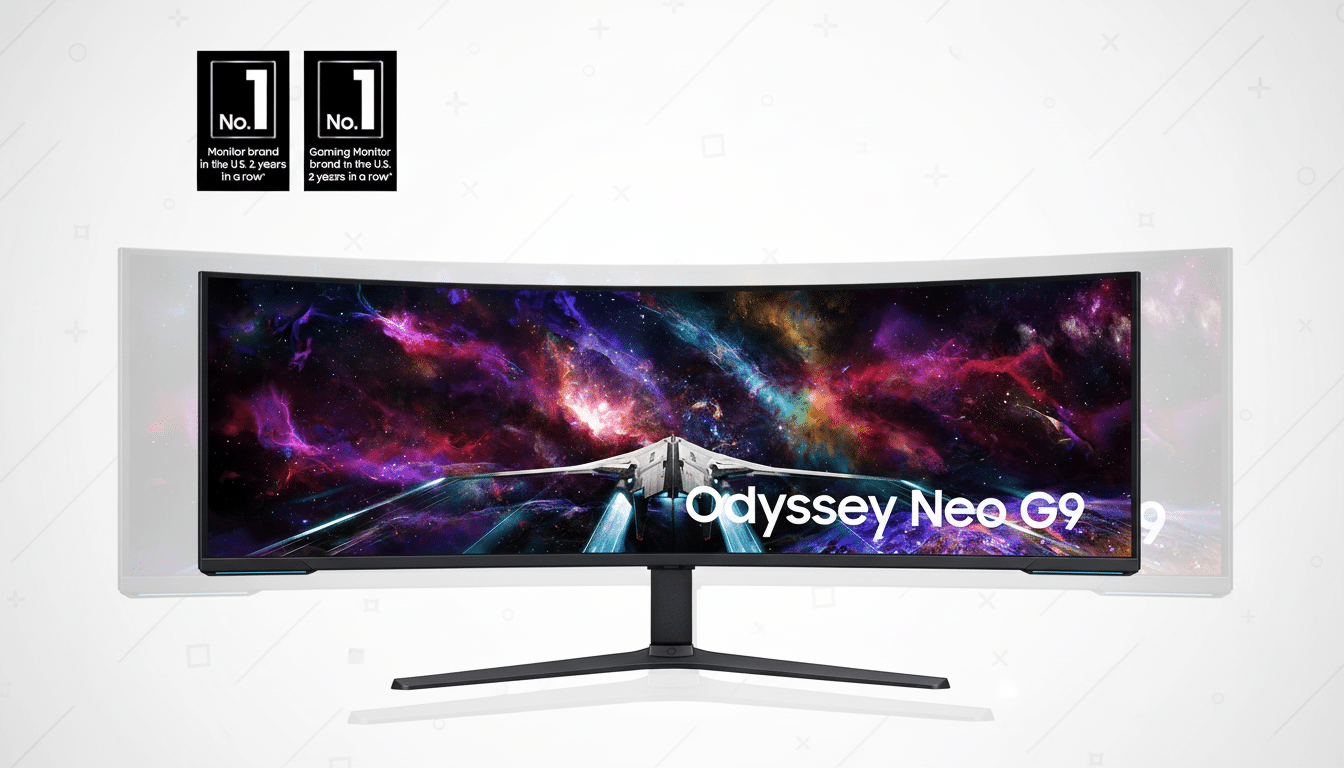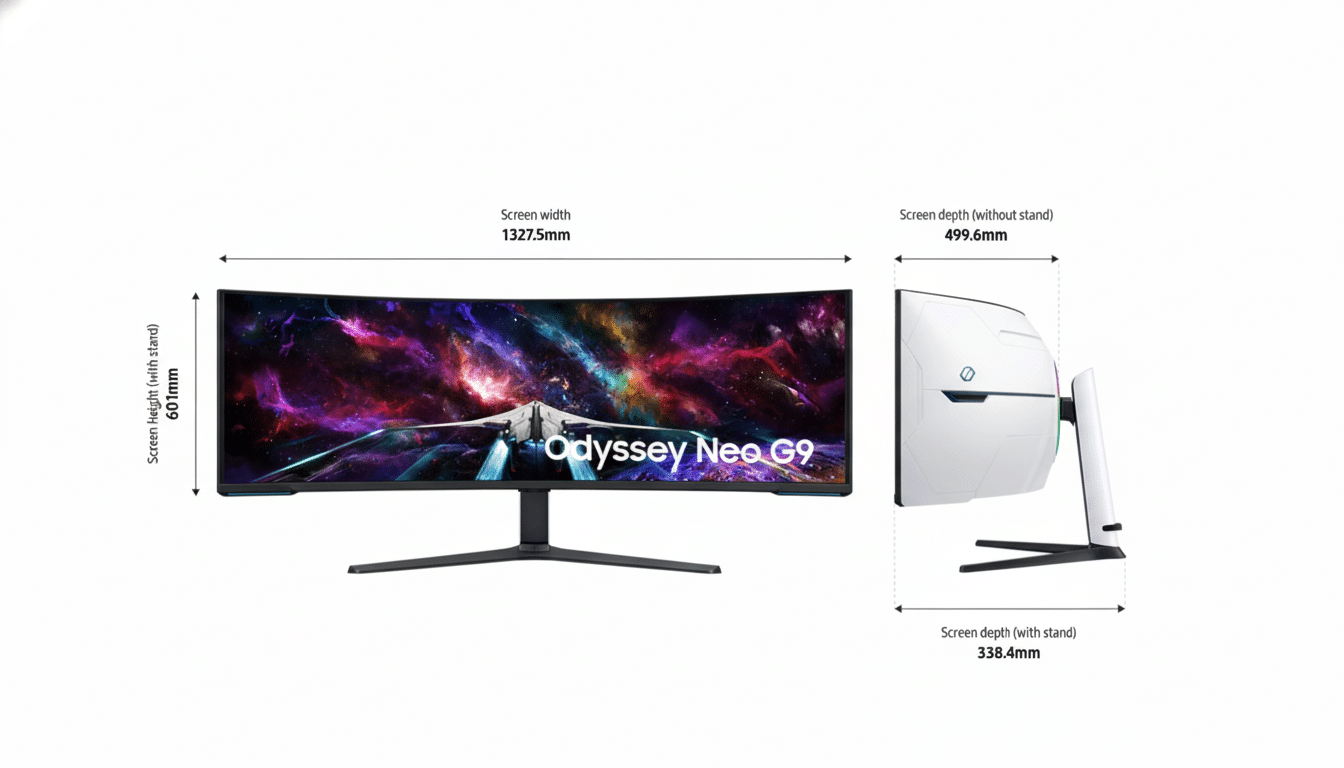If you’ve been in the market for a truly cockpit-class display, the 57-inch Samsung Odyssey Neo G9 just arrived at close to half off—or about 40% if we’re being exact—down there with flagship ultrawides at $1,499.99 from major retailers like Walmart (instead of its typical $2,500 number). For anyone managing a workstation with multiple displays or eager for an immersive ultrawide experience, this is the rare discount that actually changes what your setup can do.
Why This 57-Inch Ultrawide Is Significant
Samsung’s 57-inch Neo G9 is essentially two 4K monitors combined into one continuous panel that clocks in at a 32:9 aspect ratio. Its Dual UHD resolution of 7,680 x 2,160 fills roughly 16.6 million pixels—twice the normal 4K—so games and creative apps stretch out without having to worry about bezels or scaling hacks. It’s aggressively curved with a 1000R curve radius to replicate the curvature of the human field of view and pull your peripheral vision into the game—and get you ahead in the game instead of behind.

For work, that width keeps timelines, spreadsheets, IDEs, and browser tabs in view at once. For play, it alters the sense of speed and space in racing sims, flight sims, and open-world titles. It’s the type of upgrade that replaces a two- or three-monitor setup, while streamlining cable runs and clearing off your desk.
Specs Geared for High-End, Expensive Gaming PCs
The bullet points read like a dream list:
- 240Hz refresh rate
- 1ms response (GtG)
- AMD FreeSync Premium Pro variable refresh support
- Quantum Mini LED backlighting with full-array local dimming
Combined with VESA DisplayHDR 1000 certification, which calls for peak brightness of 1,000 nits and strict color/contrast requirements, this gives you punchy specular highlights, deep blacks, and strong contrast across a huge canvas.
This connectivity is anything but straightforward; while DisplayPort 2.1 unleashes extreme bandwidth for high refresh at Dual UHD resolution, HDMI 2.1 is also included for modern console and device support, plus a built-in USB hub to anchor peripherals.
Pushing 7,680 x 2,160 at 240 frames per second is a heavy lift; top-tier GPUs from AMD’s new RDNA 3 line and NVIDIA’s freshest RTX cards are the intended dance partners here, with help from Display Stream Compression to shove those ultra-high resolutions and refresh rates through. The competitive shooter crowd will appreciate the headroom for ultra-high frame rates, and visually rich games can hit 120–165Hz with DLSS or FSR upscaling to maintain smooth motion and keep input latency down.
Real-World Gains for Gaming, Creative Work, and More
As someone who grew up with far less peripheral exposure, in a world that wanted me to know very little about true equality, the 32:9 view takes away much of the extraneous and decorative nature of a car’s dashboard or beadlike crucifix as it hangs above the instruments.
In Microsoft Flight Simulator or Assetto Corsa Competizione, this 32:9 view transfigures instrumentation and side-window visibility—your brain reads this world faster because more of it lives in your periphery. Strategy games spread wide—and cinematic RPGs wrap around—without that distracting “letterbox” experience of a flat 16:9 panel.

Creators see equally tangible benefits. Video editors can keep a full-resolution preview, effects panels, and an unbroken timeline on screen at the same time. And photographers editing in Lightroom or Capture One get sufficient space for side-by-side before/after comparisons and expanded tool strips. Software developers can comfortably tile three or four panes on their screens and do so without the productivity drag of bezels and window shuffling. Picture-by-Picture mode is the feature that lets you feed two sources simultaneously (a game on one side, stream controls or chat on the other).
How the discount stacks up against rival ultrawides
Flagship ultrawides in this size and spec range tend to hover at the top of the market, and the Neo G9’s sticker price reflects that. An L33T-suited display—provided we see a concomitant drop with rarefied pricing—isn’t something that happens every day; it’s the kind of swing that places “halo” screens in the same price brackets as many 4K 144–240Hz panels. Retail pricing histories on premium displays indicate that deep cuts like this tend to coincide with large promotions, and they rarely stick around long beyond when stock starts to dwindle.
The long and short of it is, you’re paying midrange-4K money for a no-compromise ultrawide with bleeding-edge bandwidth, serious HDR chops, and esports-ready speed.
It’s a hard-to-beat proposition for those who would otherwise shop two quality 4K monitors—and a mount to stitch them together.
Shopping tips before you buy this 57-inch ultrawide
Measure twice, buy once. A 57-inch 1000R panel, meanwhile, requires a deep desk and/or a stand or VESA arm rated for a heavy load. Make sure your GPU can do Dual UHD output at high refresh; DP is the preferred connection to achieve peak performance. If you’re using consoles as a companion device, keep in mind that most games are 4K and will pillarbox on a 32:9 screen.
Out-of-the-box color accuracy is good for a gaming monitor, but pros should still calibrate to their workflow. As per VESA’s DisplayHDR spec and AMD’s FreeSync Premium Pro, you’ll see HDR tone-mapping accuracy and low-latency variable refresh rate—a great pairing for creators who game and gamers who create.
Bottom line: This is a rare opportunity to get your hands on Samsung’s most ambitious gaming monitor at a serious discount. If you’ve had your eye on a tidy all-in-one replacement for a multi-screen setup, the 57-inch Odyssey Neo G9 at 40% off is the kind of reduction that can redefine your setup in one fell swoop.

